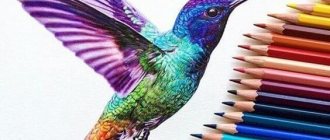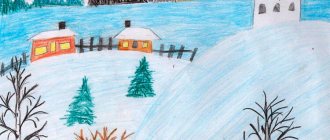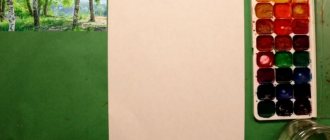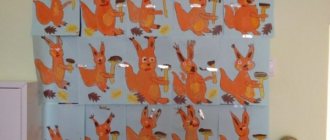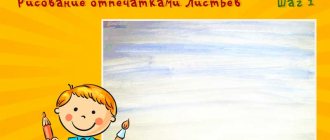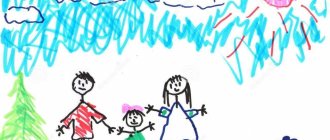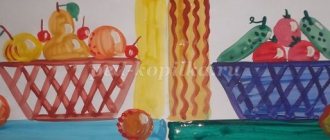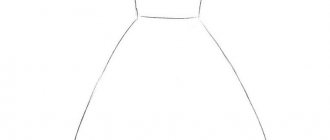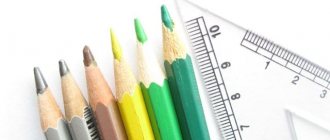Birds are an integral part of wildlife. As children begin to understand the world around them, they first learn about birds that are found literally everywhere. Pigeons and sparrows are on the streets and in parks, woodpeckers are in the forest, and swans are on lakes and ponds. You can watch them constantly.
Some are associated with the seasons. Swallows herald spring and the onset of warmth, and in winter you can see bullfinches on snow-covered tree branches.
At a young age, a child becomes interested in how to draw a beautiful bird with a pencil step by step. This activity is exciting and rewarding, but it is not easy. First you need to get acquainted with the basic techniques and rules. Parents will need help to explain the features of the image from different angles.
Materials for work
You will need to prepare in advance everything you need for the future process:
- Sheets of paper.
- Medium hard pencil.
- Black liner for contour.
- Colored, wax pencils or felt-tip pens.
- Eraser.
- Sample in the form of a picture for an accurate representation.
After the inventory is prepared, you should study the components of the bird in detail.
Veils
The skin of birds is practically devoid of sebaceous and port glands. All that remains is the coccygeal gland, the secretion of which lubricates the feathers to protect them from moisture and increase aerodynamics.
Horny derivatives of the skin are feathers; they cover the body of birds, protecting and ensuring flight. There are contour and down feathers, which differ in structure and function.
Body structure
To avoid difficulties for children on how to draw a bird with a pencil step by step, at the initial stage you need to carefully consider each part separately.
Knowledge of anatomy and how the torso works is the main task for the successful implementation of your plan. The main thing that people pay attention to is the streamlined shape of all species, which is necessary for flight.
The structure of the skeleton is absolutely the same, only the length and size of the various components of the pattern differ. Feathers, like tiles on a roof, must necessarily overlap each other. Start from the front of the crown, going down the back to the tail.
The structure of the wing is identical to the human upper limb - the shoulder, forearm and wrist. In place of the “brush”, the first feathers, called flight feathers, begin to grow. The knees are not visible; they are covered with feathers. 3 toes point forward and 1 back.
Beginning artists need to sketch. A few simple strokes will help define movement and convey the look, so even if they don't turn out as perfect, there's no need to worry about it. Their goal is to prepare a simplified sketch for further creative work.
Sketching
Sketches are essential for beginning artists. Just a few strokes allow you to determine the movement and outline of the bird. There is no need to be afraid of imperfect sketches, because their purpose is to prepare the ground for further detailed elaboration.
Each person who undertakes to draw birds must use different possibilities. The first step is to study the drawn pictures of birds. They help to understand the structure of the feather, to anticipate how light and shadow are distributed.
Dove drawing
It is considered the most peaceful bird. In this example you can see how using a pencil you can perfectly cope with a task. Often found in school wall newspapers created for Victory Day and May 1st. He brings happiness and prosperity to the world!
Step-by-step instruction:
- Create the main elements - wings, head and torso.
- They outline the head.
- An inclined line is drawn from it to depict the body. In the case of a flying dove, the tail is drawn down.
- The wings are indicated by a “tick”.
- They convey the contour of the tail and the entire body.
- Short strips are drawn for the paws.
- Draw an eye and beak.
- Feathering is applied to the wings and tail.
- Next, draw the legs.
To make it easier to draw wings, it is better to divide them into segments. The dove is ready!
Unusual specimens
There are varieties that cannot be confused with anyone else. For example, this is an overweight pelican, with a beak-bag where it stores fish, or a toucan with a special structure of a voluminous nose-beak.
Pink flamingos on elongated legs are graceful and spectacular, and the nimble swallow is distinguished by its forked tail and erected hut nests.
The highlight of the peacock is a chic blossoming fan-tail with diamond-shaped colored patterns, and its head is crowned with a “crown” of corollas with circles.
Let's depict a formidable eagle:
- We make a general sketch of the body with all its fragments.
- We start detailing from the head with a slightly open beak-hook and an eye with a pupil under the eyebrow.
- We approach the back, lowering ourselves onto the tail section.
- The sitter has sharp claws on his large paws, and specific “pants” on his shins.
- We convey the plumage on the powerful wings by shading.
We draw the stump on which the predator is sitting.
Graceful swans are impressive, associated with fidelity and love. The simplest version begins by drawing the number two flowing into the body rocking on the waves. These birds have a characteristic marking on their wide beak and webbed feet.
Fairytale character
Before you begin, you should have all the necessary accessories in front of you, including a ready-made colorful image. Then there will be no problems for beginners on how to draw a firebird step by step with a pencil.
It is necessary to take into account the important nuance that its feathers are full of different colors, glow and can burn. She looks like a Phoenix, but came from the familiar peacock.
The process is divided into stages:
- Draw the head in the form of a circle, eyes, then the beak and crest.
- Conveys the shape of the body.
- In that section of the drawing intended for the wing, draw a curved line, then draw the first layer of feathers.
- Continuing with the 2nd layer of plumage and paws.
- For a very bushy tail, wavy stripes are drawn to indicate the location of the feathers.
- They draw the feathers, drawing the eye to the tip of the feather, which looks like a tongue of flame.
Now you can admire the resulting image!
a brief description of
Birds are highly organized animals. Their high numbers and widespread distribution across the planet make them an important part of ecosystems and human activity.
Currently, the class includes 10,738 species; 789 species live in Russia.
The main characteristic features of birds are the ability to fly and associated structural features, laying eggs, and the presence of a beak.
Some species make long migrations, others roam within their habitats, and others lead a sedentary lifestyle.
In the process of evolution, birds have developed systems of visual and sound communications. They can perform actions in a group: joint nesting, hunting, protection.
Birds are of great importance in the economy. Poultry farming in the modern world is one of the leading branches of agriculture. Birds are often kept as pets.
Human activities have a significant impact on members of the class, changing their lifestyle and habitats. As a result of these changes, more than 1,000 bird species are on the verge of extinction.
Capturing the moment of flight
The most obvious example is the seagull. Even children will understand how to draw a flying bird with a pencil step by step. This process is so simple!
- The drawn circle is the basis for the head and body, the lower and upper parts are rendered slightly pointed.
- After drawing the eyes and beak, use an eraser to remove the outline of the circle.
- Draw the wingspan and tail as if flying. The wing located on the right edge of the sheet looks larger than the left one, and also larger in size in comparison with the entire body.
- The paws folded together are completed, followed by the hips, depicted by a line leading from the paw down.
- Draw wings.
- Everything is decorated with feathers.
- The final detail is the tail.
To complete the work, defects and unnecessary sketches are eliminated. It is also important to add shadow with a dark pencil on the wings, away from them and at the bottom of the image. Now you can evaluate the result!
Propulsion system
Birds' muscles allow them to perform complex movements with a high degree of coordination. The organs of movement of flying birds are wings.
The pectoral muscles are the most developed (up to 1/5 of the total body weight).
Birds that have lost the ability to fly have powerful leg muscles that allow them to run quickly on the ground.
Rainbow bird
To understand how to draw a bird on a branch with a pencil step by step, it is better to take a parrot as a sample. It is he who contains the entire available palette of colors. The detailed steps are as follows:
- Draw 2 ovals - the upper one, smaller for the head, and the lower one, larger, for the body.
- There are 4 stripes leading down from the big one, representing a tail.
- Wings are added - on top of the body in the form of a significant drop and only a partially visible wing as half of such a drop.
- Draw a beak resembling a triangle with a downward curved top.
- The drawing is checked against the original; the now unnecessary auxiliary stripes can be safely erased.
- According to the plan, the parrot is placed on a branch, represented in the figure by a wavy line. Small oval paws are drawn on top of the wood. Outwardly, they resemble a human fist.
- Depict claws.
- Several circles are drawn for the eye, one as if nested within the other. The last one is black, don’t forget to leave a point for highlight. The rest don't color.
- To make the tail look believable, the lines are sharpened.
Now you can color the bird. Macaw parrot is reddish in color with a yellow beak! For greater diversity, the wings are made orange. For a bright tail, use the entire set of pencils. Truly, all the colors of the rainbow are represented here!
Children enjoy drawing different birds, as they strive to capture the contours they see on paper. Having mastered the initial skills, you can complicate the task each time, come up with new ideas and achieve real perfection for depicting any bird!
Small breeds
Sparrows are the most common family; their oval body is equipped with a round head and a triangle-beak. Draw the wing, eye and thin legs. An interesting titmouse with a round yellow belly.
The smallest bird is the hummingbird, which is distinguished by its long nose, thickened at the base, with which it drinks nectar from flower buds; it has also earned fame for its ability to fly backwards. The picture will turn out believable if you carefully work out the feathers of the birds.
Digestive system
The high metabolism of birds is supported by a digestive system of a specific structure. Food captured by the beak travels through the esophagus into the crop, where it swells and begins to be digested.
The anterior section of the stomach is glandular, where the chemical breakdown of nutrients takes place; in the second section, the muscular section, mechanical grinding of food masses takes place. Afterwards come the duodenum and small and large intestine, which opens into the cloaca, along with the ducts of the excretory and reproductive systems.
Digestive enzymes are synthesized by the pancreas and liver.
Circulatory system
In representatives of the class of birds, a separation of arterial and venous circulations appears for the first time.
The heart has four chambers, so venous and arterial blood pass through it without mixing. The consequence of separation is intense gas exchange and constant body temperature, that is, warm-bloodedness.
